Hazards to farm machine operators that can't be designed around must be shielded to protect the operator from injury or death. Guards and decals which identify the danger must be kept in place whenever the machine is operated. Guards or shields removed for maintenance must be properly replaced before use.
Numerous farmers, children, and farm workers have been permanently maimed or killed because guards were not installed or were improperly used. Repair or replace damaged guards and shields.
Moving parts present the greatest hazard because of the swiftness of their action and unforgiving and relentless motion. Common machine hazards occurring around moving parts include:
PINCH POINTS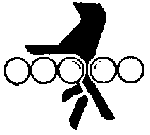 Where two parts move together and at least one of them moves
in a circle; also called mesh points, run-on points, and entry
points (see Figure).
Where two parts move together and at least one of them moves
in a circle; also called mesh points, run-on points, and entry
points (see Figure).
Examples: Belt drives, chain drives, gear drives, and feed rolls.
When shields cannot be provided, operators must avoid contact with hands or clothing in pinch point areas. Never attempt to service or unclog a machine while it is operating or the engine is running.
WRAP POINTS
 Any exposed component that rotates (see Figure).
Any exposed component that rotates (see Figure).
Examples: Rotating shafts such as a PTO shaft or shafts that protrude beyond bearings or sprockets.
Watch components on rotating shafts, such as couplers, universal joints, keys, keyways, pins, or other fastening devices. Splined, square, and hexagon-shaped shafts are usually more dangerous than round shafts because the edges tend to grab fingers or clothing more easily than a round shaft, but round shafts may not be smooth and can also grab quickly. Once a finger, thread, article of clothing, or hair is caught it begins to wrap; pulling only causes the wrap to become tighter.
SHEAR POINTS
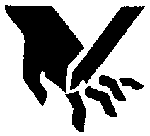 Where the edges of two moving parts move across one another
or where a single sharp part moves with enough speed or force
to cut soft material (see Figure).
Where the edges of two moving parts move across one another
or where a single sharp part moves with enough speed or force
to cut soft material (see Figure).
Examples:Sickle bar mowers, rotary shredders and cutters, cutter heads of forage harvesters, augers in tubes, chain and paddle conveyors, certain points in an implement frame during raising or lowering, hedge-trimming shears, and rotary mower blade.
Remember that crop cutting devices cannot be totally guarded to keep hands and feet out and still perform their intended function. Recognize the potential hazards of cutting and shear points on implements and equipment that are not designed to cut or shear. Guarding may not be feasible for these hazards.
CRUSH POINTS
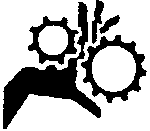 Points between two objects moving toward each other or one
object moving toward a stationary object (see Figure).
Points between two objects moving toward each other or one
object moving toward a stationary object (see Figure).
Examples:Four-wheel drive tractor with articulating steering which pivots in the middle, working under a raised heavy object like a combine head, hitches, telescoping shafts, hoods, and doors.
Guard yourself! Never stand between two objects moving toward one another. Make certain the driver knows where the helper is at all times when hitching a tractor to an implement. Do not move between the two objects to complete the hitching until the backing vehicle is completely stopped and the brake is set. Never stand between the tires of an articulating four-wheel drive tractor. Use adequate blocking or lock-out devices when working under equipment.
PULL-IN POINTS
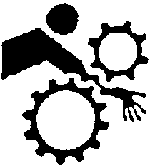 Points where objects are pulled into equipment, usually for
some type of processing (see Figure).
Points where objects are pulled into equipment, usually for
some type of processing (see Figure).
Examples:Feed rolls, grinders, and forage harvesters.
Machines are faster and stronger than people. Never attempt to hand-feed materials into moving feed rollers. Always stop the equipment before attempting to remove an item that has plugged a roller or that has become wrapped around a rotating shaft. Remember that guards cannot be provided for all situations--equipment must be able to function in the capacity for which it is designed.
Freewheeling parts, rotating or moving parts that continue to move after the power is shut off are particularly dangerous because time delays are necessary before service can begin.
More examples are: cutter heads of forage harvesters, hammermills of feed grinders, rotary mower blades, fans and blades on ensilage blowers, flywheels on balers.
Allow sufficient time for freewheeling parts to stop moving. Stay alert! Listen and Watch for Motion!
THROWN OBJECTS
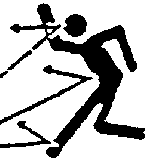 Any object that can become airborne because of moving parts
(see Figure).
Any object that can become airborne because of moving parts
(see Figure).
Examples:Rocks, stones, sticks, and pieces of chopped or cut crops.
Keep shields in place to reduce the potential for thrown objects. Wear protective gear such as goggles to reduce the risk of personal injury if you cannot prevent particles from being thrown.
Michigan Occupational Safety and Health Administration (MIOSHA) standards require the following for all farm equipment operated by employees:
Tractors must have a master shield over the PTO drive. Connected equipment must have a tube or tunnel guard over the PTO shaft. Safety decals must be on equipment and must be clearly visible.
All guards, shields or access doors must be in place when equipment is operating.
A warning decal must be placed on an access door when removal of the door would expose the operator to a component that rotates after power is shut off ("freewheeling").
Electrically powered equipment must have a lock-out control on the switch or an electrical switch, mechanical clutch or other positive shut-off device mounted directly on the equipment (such as a silo unloaders, bottom unloading grain bin, or other remote equipment).
Circuit interruption devices on an electric motor, such as circuit breakers or overload protection, must require manual reset to restart the motor. Exceptions include bulk milk coolers, water pumps, or other operations where manual resets would be unduly burdensome. Employees must receive instruction on safe operation and servicing of all field machinery or farmstead equipment with which they are involved. Give instruction at the time of the first assignment to work on each machine and at least once a year thereafter.
These guidelines should be applied to equipment operated by family members also.
This information is for educational purposes only. Reference to commercial products or trade names does not imply endorsement by the Cooperative Extension Service or bias against those not mentioned. Cooperative Extension Service programs are open to all without regard to race, color, national origin, sex or handicap. MSU is an Affirmative Action/Equal Opportunity Institution.
Disclaimer and Reproduction Information: Information in NASD does not represent NIOSH policy. Information included in NASD appears by permission of the author and/or copyright holder. More